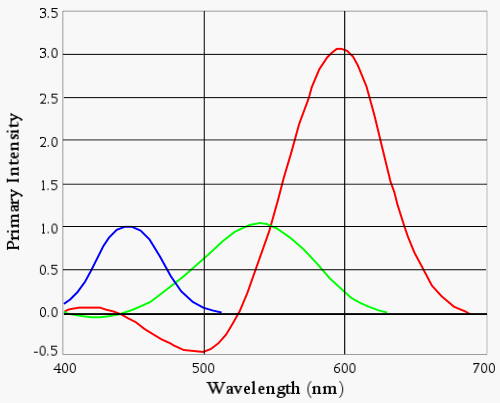Sony's announcement suggests that the company is moving away from chasing megapixels, instead calling consumers' attention to the fact that other characteristics can have just as much - if not more - effect on your images. Earlier this year, competitor Fujifilm took a similar stance when it announced its proprietary fourth-generation SuperCCD SR image sensors, which are aimed at improving dynamic range in digital images. Now, Sony's new "RGB+E" CCD image sensors are aiming to increase color accuracy, fine-tuning the color arrays to better gel with the quirks of human color perception.
At this point, a little background information is necessary (and we do mean a little - color scientists can feel free to skip the next couple of paragraphs!). What we perceive as color is actually light energy of varying wavelengths, detected by two types of light-sensitive receptors in the retina of the eye, called rods and cones. Rods detect only the quantity of light photons stimulating them, and work at low light levels - right down to a single photon - giving you night vision. Cones, of which there are three types, require hundreds of photons to activate them, and are capable of detecting the wavelength of the light being received. Each cone type has a different sensitivity curve, and responds most strongly to light of certain wavelengths. Our brains understand the resulting information as colors.
Digital cameras, meanwhile, render color using a color filter array over the surface of the image sensor, which limits each pixel to be able to see only light of specific wavelengths - most commonly using Bayer pattern filters of red, green and blue. There's a fundamental problem with this, though. To simplify greatly, at certain frequencies the human eye has a negative response to red light. As bizarre as it may sound, this is something that has been ascertained in tests where numerous observers are asked to match a monochromatic light source of a particular wavelength with a mixed RGB light source consisting of red, green and blue primary lights. At wavelengths near 500nm, the only way to get the mixed light to match the monochromatic light is through the use of a subtractive filter on the red channel.
The illustration below shows the "Color Matching Function" for the human eye. The red, green, and blue lines show how much of each color is needed to match a monochromatic light source having the wavelength displayed along the x-axis of the graph. The "negative red" phenomena corresponds to the dip in the red curve near 500 nm, a blue-green color.

Obviously there's no such thing as negative red, but a particular blue-green color which Sony is calling Emerald - hence the E in RGB+E - can used to quantify the amount of "negative red" present in a scene. (The lump in the spectrum corresponding to the "emerald" filter's passband roughly corresponds to the band of wavelengths where our eyes show the "negative red" response.) Where currently in a 16 pixel area a Bayer filter array would have 4 red, 4 blue and 8 green sensors, Sony's new filter array would have 4 each of red, green, blue and emerald. (Conveniently, the "emerald" channel is close enough to green that it still carries a lot of the luminance information that our eyes respond to as well. Thus, it can substitute for the extra green pixel in each unit cell of the sensor array, to produce the increased spatial resolution normally resulting from the doubled green sensor.) That in itself is not the whole story though - the image formats and software we use generally work in an RGB color space, and were Sony to add a fourth color to the mix, then your existing software would be useless. Hence, after the RGB+E image is captured, it must be processed back to RGB using a linear matrix. The result, says Sony, is a three-color RGB image that is closer to what human perception sees...
Alongside the new image sensor, a new image processor has been developed to handle the linear matrix processing to map the four-channel sensor data back into the usual RGB color space. Sony says this processor uses 30% less power, and offers opportunities for both high-speed image shooting and high-speed playback.
Sony staff says that the results of these new technologies are striking both on a monitor and in prints. We have to note at this point that we've not seen any samples ourselves beyond the one very low-resolution image in this news item, so we can't yet comment ourselves. Beyond just the color rendering benefits though, Sony is expecting to see benefits for white balance on RGB+E cameras. With an expanded color spectra to work from, cameras should have a better ability to render color under differing light conditions.

No word has been given on a timeframe for any RGB+E products to be announced, beyond a statement that "Sony plans to integrate the newly developed 4 color filter CCD and the new image processor into the new digital cameras which will be introduced in the near future". Stay tuned to our news page, and as soon as anything develops, you'll hear it here! In the meantime, Sony's Technology Development document on the RGB+E CCD follows:
Technology Development
No. 03-029E
July 16th, 2003
Realization of natural color reproduction in Digital Still Cameras, closer to the natural sight perception of the human eye
Technology development to realize 4-color filter CCD and New Image Processor, achieving halving of color reproduction error
(Tokyo, Japan) – Sony Corporation today announced the world’s first practical consumer (home) use of CCD with 4-color (Red <R>, Green <G>, Blue <B> + Emerald <E>) filters, together with a new image processor corresponding to the 4-color filter. By this technology, the color reproduction error is halved compared to Sony’s conventional 3-primary-color filter CCD and, expression of images closer to the natural sight perception of the human eye is achieved under various shooting conditions..
| | |
| 3-color filters | 4-color filters |
Conventional digital still cameras mainly use 3-primary-color filter CCD, and the colors are recorded by the intensity of each of the 3 colors, Red(R), Green(G) and Blue(B), corresponding to the color reproduction characteristics of the color TV or monitors. However, the characteristics of these CCD filters are different from those of the human visual system. Color differences therefore emerge compared to natural human sight, resulting in different color reproduction.
In the 4-color filter CCD, a filter with the Emerald (E) color is added to the conventional 3-color RGB filter, in order to reduce the color reproduction errors and to record natural images closer to the natural sight perception of the human eye. As a result, the characteristics of the CCD color filter become much closer to those of the human visual system, achieving dramatic reduction in the color reproduction error.
In addition to the development of the 4 color filter, a new image processor corresponding to the 4-color filter has been developed. With this processor, each of the signals captured by the 4 colors is processed to produce ideal 3 colors close to the natural sight perception the human eye by a matrix calculation. Also, in addition to functioning with 30% less power consumption, by the efficient processor management, functions such as high-speed image shooting and high-speed playback are realized, as well as enhancing the of overall basic functions of digital still cameras.
By the combination of the 4 color filter CCD and the new processor, color reproduction errors have been minimized by half, and the reproduction of blue-green and red colors has been particularly enhanced.

New image processor
| | |
Photo produced by conventional technology | Photo produced by new technology |
Sony plans to integrate the newly developed 4 color filter CCD and the new image processor into the new digital cameras which will be introduced in the near future. This unique Sony original technology will offer the capability to shoot images with enhanced reality.
Sony will continue to further improve the technology in order to enhance image quality in the growing digital still camera market, with the aim of offering customers more fun and joy in taking pictures.